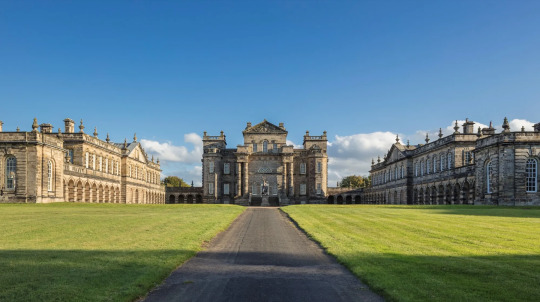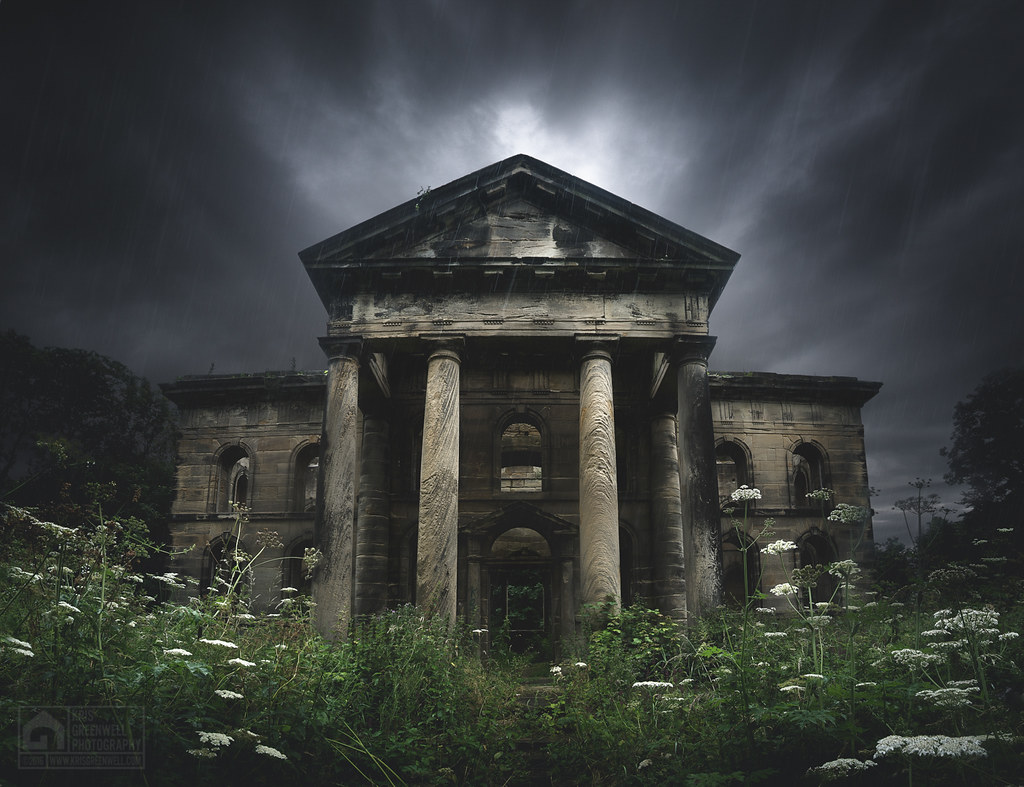#Seaton Delaval Hall
Text
National Trust Seaton Delaval Hall
A wonderful place for a family day out with the kids or on your own. Great place for photography opportunities. The interior and exterior of the hall have been lovingly restored and renovated. Definitely recommend visiting this manor house.
#warrenwoodhouse#2024#places to visit#popular attractions#manor houses#seaton delaval hall#national trust#national trust seaton delaval hall#seaton valley#tynemouth#north east england#northumberland#england#uk#VisitEngland#attractions#attraction
0 notes
Text
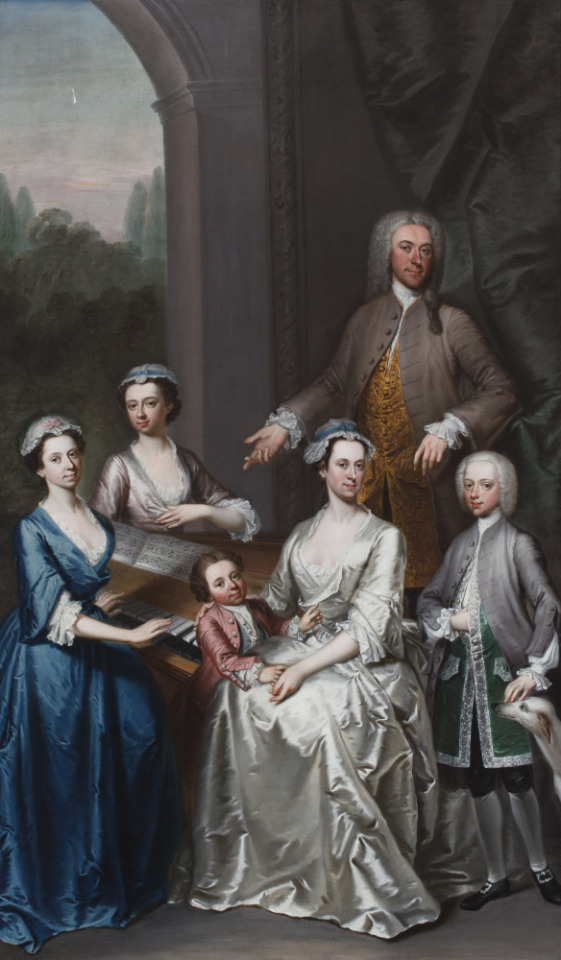
ab. 1730 Attr. to Petrus Johannes van Reysschoot - Sir Jacob Astley, 3rd Baronet Astley of Hill Morton, with his wife, Lucy L'Estrange, Lady Astley and their children: Isabella Astley, Blanche, later Mrs Edward Pratt, the Reverend John Astley and Edward Astley, later Sir Edward Astley 4th Bt
(Seaton Delaval Hall)
64 notes
·
View notes
Photo



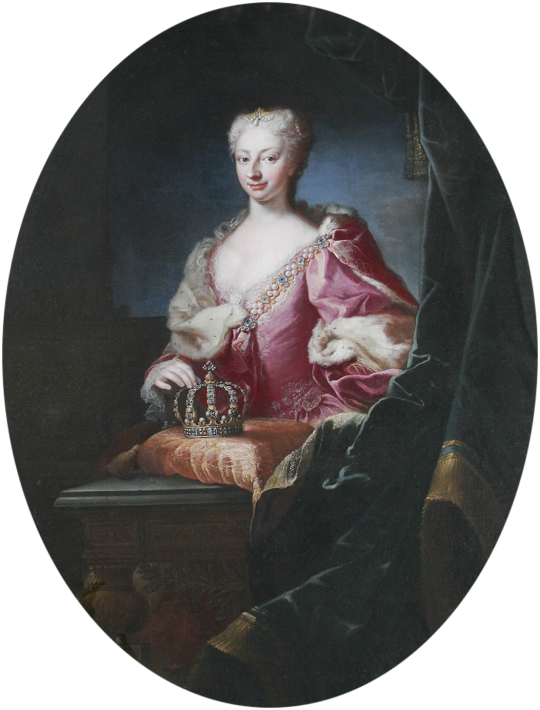
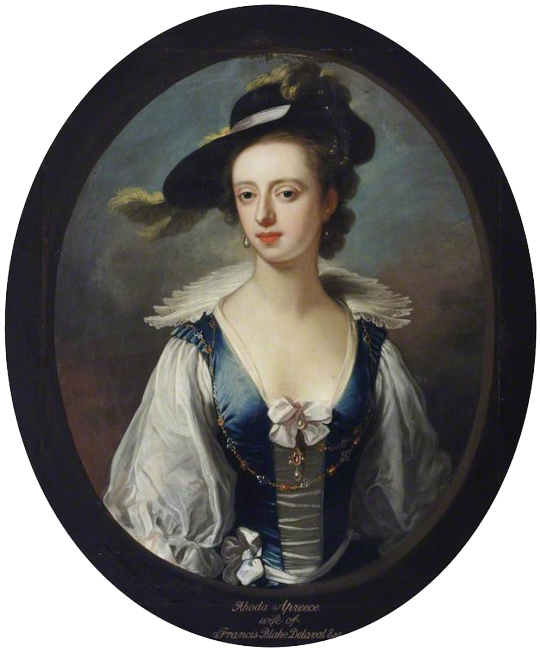
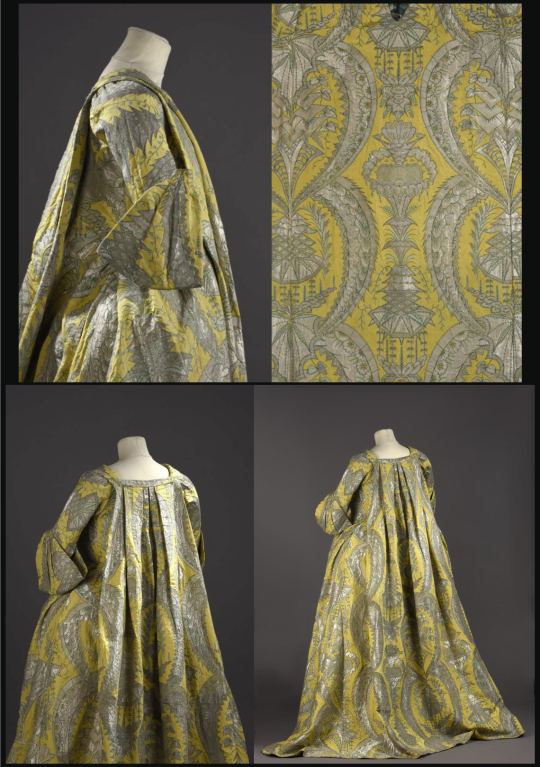
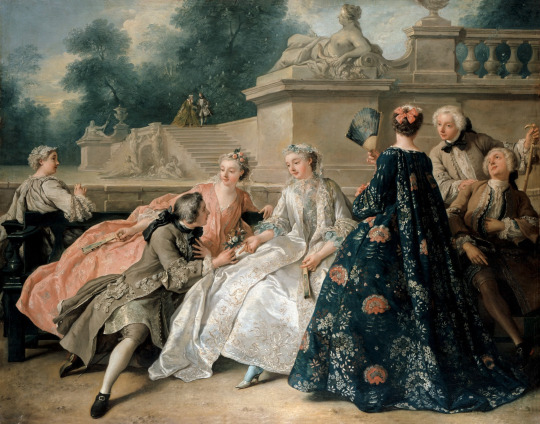



Early 1730s dresses (from top to bottom) -
1730 Tea Party at Lord Harrington's by C. Phillips detail (Yale Center for British Art, Yale University - New Haven, Connecticut, USA). Probably from Wikimedia; fixed spots with Pshop 1247X1623. There are many caps and veils, square necklines, and laced bodices with revers. But full-blown panniers are not to be seen.
1730 Marquise de Gueydan as Flora by Nicolas de Largillière (Musée Granee - Aix-en-Provence, Bouches-du-Rhône, Provence-Alpes-Côte d'Azur, France). From cutlermiles.com/portrait-of-marquise-de-gueydan-as-flora-nicolas-de-largilliere/ 1908X2484. She wears a stout Swiss belt and cleft coiffure that harken back to the late Louis XIV era.
ca. 1730 Empress Elisabeth Christine by Johann Gottfried Auerbach (auctioned, probably by Lempertz). From Wikimedia trimmed 1715X2352. She wears a round skirt and a scoop neckline.
ca. 1730 Polyxena of Hesse-Rotenburg, Queen of Sardinia by Maria Giovanna Clementi (location ?). From tumblr.com/blog/view/jeannepompadour; enlarged by half 1053X1385. Her dress has a deep V neckline filled in by a modesty piece.
ca. 1730 Rhoda Apreece, Mrs Francis Blake Delaval attributed to Enoch Seeman the Younger (Seaton Delaval - Seaton Sluice, Northumberland, UK). From artuk.org; enlarged by half 994X1200. The ruff makes this a Van Dyck revival dress. The laced vest and jaunty hat lend a casual air to the portrait.
ca. 1730 Robe volante (Musée de la Mode - Paris, France). From fripperiesandfobs.tumblr.com-post-139802377452-robe-volante-ca-1730-from-the-palais-galliera 1140X1620. Dresses before the 1750s often had cuffs that could be substantial like these.
1731 Die Liebeserklärung by Jean François de Troy (Sanssouci, Stiftung Preußische Schlösser und Gärten Berlin - Brandenburg, Germany). From artsandculture.google.com/asset/die-liebeserklärung-jean-françois-de-troy/XAFpCyLiWrxHZw?h 3074X24.12. Known in the Anglophone world as “The Declaration of Love. The large patterns mark this as early century. The robe à la française is firmly established in the form it would take until the late Louis XVI period.
1731 Infanta Maria Teresa Antonia de Borbón by Jean Ranc (Museo del Prado - Madrid, Spain). From their Web site; removed spots and streaks with Photoshop 2621X3051. Spain was ruled by Borbóns after the last Habsburg was cleared out in the early 1700s.
1731 Julia Calverley, Lady Trevelyan, by Enoch Seeman the Younger (Wallington Hall - Wallington, Northumberland, UK). From nationaltrustcollections.org.uk/object/584399; erased navigation marks in corners & fixed spots w Pshop 1616X1992. Clasps replace lacing to close this bodice.
1731 Lady by John Vanderbank (location ?). From the Philip Mould Historical Portraits Image Library 920X1214. The dress is Van Dyck revival similar to the one worn by Rhoda Apreece.
#1730s fashion#Georgian fashion#Louis XV fashion#Rococo fashion#C. Phillips#Marquise de Gueydan#Nicolas de Largillière#Kaiserin Elisabeth Christine#Johann Gottfried Auerbach#scoop neckline#Polyxena von Hesse-Rotenburg#Maria Giovanna Clementi#Rhoda Apreece#Enoch Seeman the Younger#feathered hat#robe volante#The Declaration of Love#Jean François de Troy#robe à la française#Infanta Maria Teresa Antonia de Borbón#tabbed bodice#Jean Ranc#Julia Calverley#cap#John Vanderbank
60 notes
·
View notes
Text
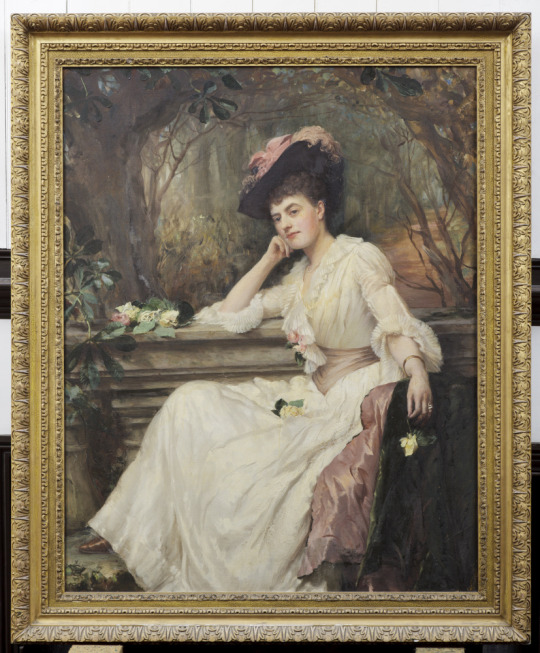
Archibald James Stuart-Wortley (British, 1849-1905) • Elizabeth Evelyn Harbord, Lady Hastings • 1880 • Seaton Delaval Hall, Northumberland • National Trust - Seaton Delaval Hall, Seaton Sluice, England.
#art#painting#fine art#archibald stuart-wortley#british artist#english painter#portrait#full-length portrait#female portrait#society portraits#women in white#la robe blanche#white dress#women in paintings#19th century british art#artist
21 notes
·
View notes
Text
Catherine Parr’s depictions-part 1: large portraits
Since I’ve been unexpectedly digging in Catherine Howard and Anne of Cleves’s portraits, I’ve decided that I might just as well do same with Catherine Parr.

The uncertainity lies mainly with her miniatures(which will be in part 3). But before we look at them, we must take closer look at portraits of hers, to establish her basic features. How her features truly looked and then look at the disputed portraits.
For this I will be using mainly larger scale portraits of her. They are either full-lenght or half-lenght portraits. By the way,since 5′10′’ was lenght of her coffin, it stands to reason that she was shorter than that.
What portraits won’t show you is that her hair was probably between strawberry blond and light red, as hair taken from her tomb suggest.

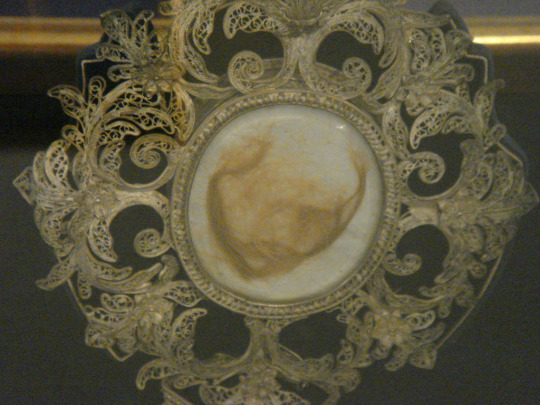
One lock(and some portraits) suggest it was darker(and more red) around roots and possibly lighter lower towards ends:

The platinum blond lock is definitely fake.
Queen Katherine Parr, copy done in 1908 by William George Tennick, Kendal Town Hall, UK:

Link:https://artuk.org/discover/artworks/queen-katherine-parr-143164/view_as/grid/search/keyword:katherine-parr-959651/page/1
There are several versions of Catherine Parr’s portrait as widow. All of them copies. Imo all of them are mislabelled. Supposedly they are after Hans Holbein the Younger. Yet they Catherine Parr as widow to Henry VIII(hence in 1547/8). Holbein died in 1543!!! So either wrong painter, or wrong dating or both! Imo, both.
Because even from copies, you can tell that the style of some strongly suggest we are not looking at Holbein’s workshop but rather at work of Ambrosius Bensen.

Benson’s portrait lady Stafford is on left. Catherine Parr’ on right adn it is so grossly misdated it makes me wish to cry!
Supposedly Parr is c.1547/1548, while Stafford is c.1535(imo it is at earliest late 1530s, not mid). No way these are 10+ years apart! Not a chance! These might not even be 2 years apart. But why do I think that? Fashion!
Width of chest, is something Benson tended to overexagerate. The style of mourning headwear, also points towards 1530s, rather than than 1550s.
The style of folded undersleeves of Stafford is also style which would fit 1538-1543, imo closer to 1538. The most important detail here is the waist-line. It’s horizontal. It’s max early 1540s. Benson was absent from home (presumably due to work) in between 1539-1543. Perhaps he was in England!
My conclusion? It cannot be Catherine Parr as widow to Henry VIII, but as widow to baron Latimer. And that gives us the most accurate dating you could ask for! Between 2nd March and 12 July 1543. (Between death of lord Latimer and wedding to Henry VIII.) Rarely we have dating this precise.
Such dating could bring Holbein back as possible maker, but the style imo is not his workshop.
However the painting could be misidentified and not be Catherine Parr at all! Yes, it has features very alike Parr, but that could be the reason why this could then be misidentified as Parr. However this is french-styling of necklace, and suggest that sitter is french. I cannot disprove that possibility. Imo, we cannot be certain this is indeed Parr.
Catherine Parr, 17th century copy after Master John(imo after Scrots), National Trust Collection, , Seaton Delaval Hall, UK:

Tbh for copy it is very well done. I have actually thought it was original. NTC calls it the Seaton Delaval portrait(because it is there now), but some webpages refer to it as Hastings portrait or Melton Constable(Hall), probably refering to painting’s past location and owners.

This copy shows vividly red hair(which might have not been on original) and curled up(shortlived fashion). Eyes seem grey or hazel to me, but the discoloured varnish may be playing tricks on us.
Link: https://www.nationaltrustcollections.org.uk/object/1276906
Catherine Parr, the Jersey Portrait(Private Collection?):
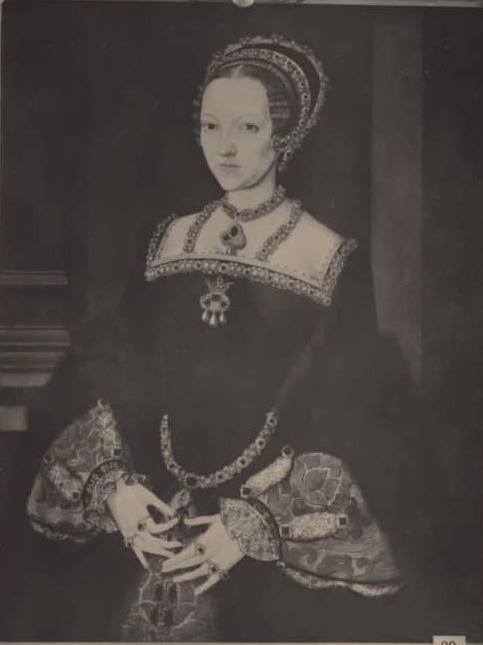
I tried to find more information about it, but these two webpages were basically only sources of information-and I cannot confirm accuracy of either:
https://tudorqueen6.com/2012/12/12/queen-katherine-parr-the-jersey-portrait/
https://ladyjanegreyrevisited.com/2019/04/01/the-stowe-house-portraits/
Basically it is in private collection, was concluded to be Catherine Parr and it is 16th century work(but that can still mean it is a copy). Unfortunately these are the best quality pictures in colour that we have:

This one is probably the best:

And to me this one certainly strikes closer to golden strawbery blond than to red, but it can be due to poor quality of picture and due to discoloration of varnish.

Seaton Delaval and Jersey portrait are almost exactly the same, except colour of overgown and cuffs being in blackwork in Jersey portrait. Even the pillar behind them is in exact same spot. It’s possible they were not ment to be two separate portraits, but rather that one is copy of the other. But not necessarly. Sometimes royals had multiple very similiar portraits made.
Catherine Parr by unknown artist, late 16th century, National Portrait Gallery:

Link:
https://www.npg.org.uk/collections/search/portrait/mw01147/Katherine-Parr?LinkID=mp00803&search=sas&sText=parr&OConly=true&role=sit&rNo=1

In closeup her eyes look grey, possibly hazel(grey-brown) and her hair look red, or reddish brown.
I found some webpages refering to this painting as original done in her lifetime atributed to Scrot. But National portrait Gallery which owns it clearly disagrees. It could be done after original by Scrot, but they don’t even mention that on their webpage. Though tbh I think their webpage could do with some improvements.
National Trust Collection( Anglesey Abbey, Cambridgeshire, UK to be exact) has another version of this portrait, 18th century copy. Link:
https://www.nationaltrustcollections.org.uk/object/515505

It’s too dark to have conclusive say about eye and hair colour.

The differences with previous version are negligeable-mainly the collar is different and the parlet is in blackwork’with different pattern and its edge is firmer, but today I am not trying to do lineup of Catherine Parr’s portraits. (Unless you’d want me to.)
Catherine Parr by Master John(it is an original!), National Portrait Gallery, UK:
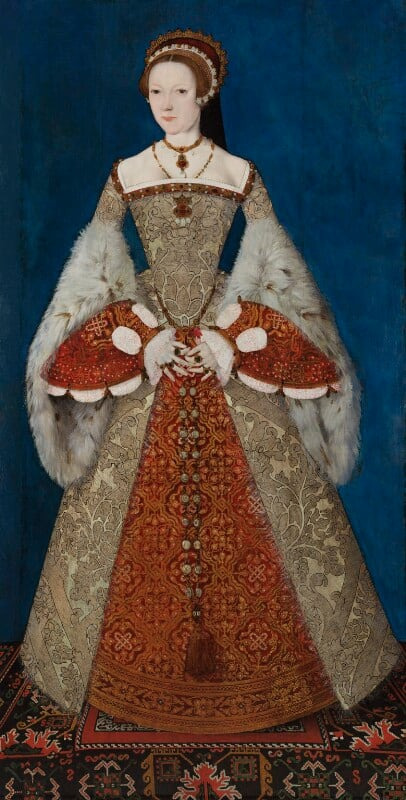
Link:https://www.npg.org.uk/collections/search/portrait/mw01957/Katherine-Parr?LinkID=mp07168&role=art&rNo=1
The webpage includes videos about its restoration-where they refer to incredible Azurite pigment used for the background. They are talking about real ultramarine(just different name for it). That alone be expensive as hell, especially given this is full-lenght portrait. But there is also gold-leaf, silver-leaf, fluorite, lots of very expensive materials were used to make it. And the materials alone are enough to conclude sitter is royalty and certainly had more than 9 days to be painted.

Link to conservation findings it: https://www.npg.org.uk/collections/search/portraitConservation/mw01957/Katherine-Parr
If we look at closeup in colour-sitter had very fair skin, the eyes are grey, the hair seems as light golden brown, but strawberry blond or light red hair can create such ilusion:

Nose appears to be flat and oddly shaped. Normally I’d say that is due to pigment instability. However I have dived deep into conservation findings upon the painting and now I am not certain about the cause, but it is an issue.
NPG notes that ‘the underdrawing is extensive and complex to decipher. The style of the drawing is free and sketchy, only very loosely delineating some of the form and structure of the figure, such as the sleeves. This type of underdrawing, is in direct contrast to the underdrawing found in Mary I (also attributed to Master John) where the key elements of the composition are carefully transferred through a pounced technique.’
Master John didn’t take such care with underdrawing of Parr’s portrait, as he did with Mary’s. Perhaps Mary wanted to sit for it just once or had better idea how she wanted to be portrayed. Parr’s portrait vs underdrawing shows that final design was improved upon. It was changed a lot. They know this due to x-ray and infra-red analysis(bellow):
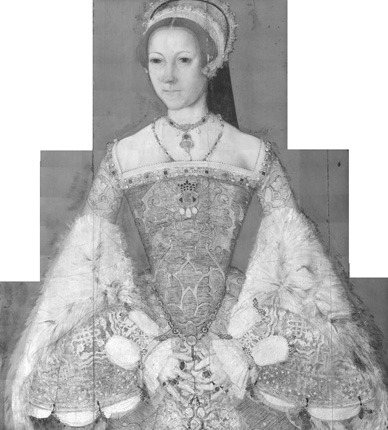
Most important changes to the face include:
- the eyes moved slightly to the right,
- hairline has be re-positioned and was originally slightly lower
- nostril has been re-positioned
These changes are big problem, because this is the only original painting of Parr and we cannot trust these features 100%.
However fear not! Under infra-red light(in middle bellow), it is obvious the face looked very alike to majority of the paintings:

And it is not that different under normal light as well.
Bigger closeup so you can see it properly. This is Catherine Parr’s face:
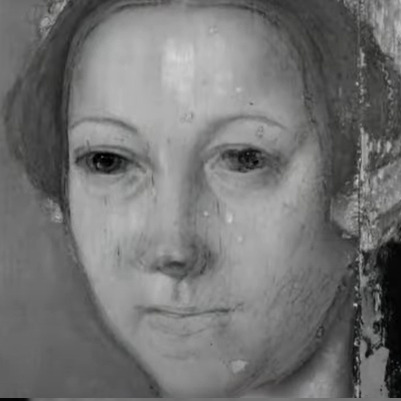
It is. But before I dive deep into what shape of nose she actually had I want to show you how easy would it be for me to say it might not be her (Mary I on right by same artist):

Spoiler alert-it’s not Mary, they just looked more alike then you’d think.
The identification of sitter as royal is no doubt correct. The materials and jewelry certainly are conclusive on that. But assuming that jewel worn by Catherine Howard was then part of collection of Queen’s jewels worn solely by Queens, is very wrong! There are portraits of Mary and Elizabeth in jewelry worn by Queens. Hence Mary should have been included as possible sitter and I am susprised it is not mentioned anywhere that at some point they excluded her.
HOWEVER, some painters had tendency to paint anybody in such similiar way, you cannot tell them appart that well. That could have been case with master John. Both women had similiar colouring and perhaps more similiar features than you’d think, but they didn’t have same height.
Catherine Parr was not 5′10′’-that was lenght of her coffin! She’d be much smaller, but she wasn’t short for sure(she was probably higher average), unlike Mary who was notably short! If you compare not just face-but lenght of torso and overall shape of figure, you’re realise it it is not same woman.
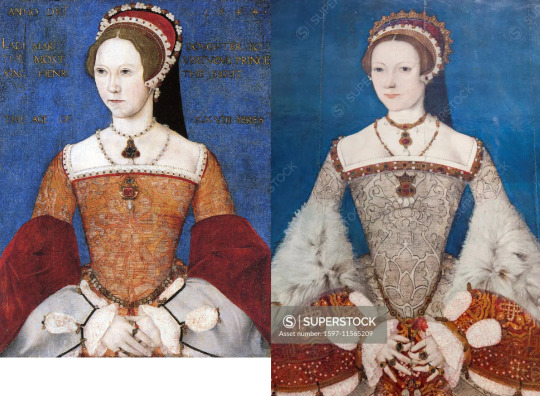
However if you compared just infra-red photo of face of Parr, you could easily come to wrong conclusion. I had initial bout of panic, seeing the very similiar face! Then I did my due diligence.
Catherine Parr’s portrait is photographed bit under an angle(I couldn’t find close up which wouldn’t be), however this is properly scaled down to aproximately same size of torso. Even though if you might scream that no-lady in silver dress obviously has longer torso, and I should have scaled it differently.
What you’re not taking into account is different shape of stays. I could elaborate, but long story short check where girdles disappear to the back(front changed, backside didn’t), andn where armits are. Aproximately at same level. Just women with different height, figure and shape of stays.
So imo, it’s Parr. The identification is correct. However, there might have been much bigger similiarities in facial features of Mary and Parr, and we have to take that into account in the future. It will make identifying some portraits more difficult.
Another difficulty is that we can’t tell the exact shape of nose from neither form of painting.
I have attempted do a ‘nosejob’ upon the infra red photo, using app similiar to photoshop and retouching tool. But I never quite got it correct, so I am nof going to show you even. I thought she was looking more to front, but then there was never enough space for alla on right side, so the nose was more to side and towards left from our POV, just like Mary’s was. It’s exact shape remains mystery to me.
Problem is the underdrawing truly is complex:


I give up. I don’t know what her nose was like. Although if you ask me, then the other painting NPG has of Parr, is imo the closest match in all features:

So perhaps that shape of nose is also very similiar to Parr’s real features. However, it might just be the case that this particular feature(nose) the artist screwed up.
Sadly, the marble effigy of Parr(the sculpture on her tomb) is not original and we cannot use it to decide this matter.
I don’t think we will be ever able to get 100% conclusive idea about the true shape of her the nose. Which is disapointing, however I believe that the nose was at least level if not pointed slightly upward. The undersketch of this original painting supports my theory. Even though due to flatness issue the nose under normal light seems to be against that(misleading us).
It’s never prominently low hanging nosetip with Parr in all copies of her portraits either(those that public agree upon). Except in one!
I have for long suspected one painting to not be Parr, firstly solely due to hair colour. But after I found out her hair could have been strawberry blond, I let it go, telling myself the painter simply did mistake. It happens all the time! Especially in copies which this painting is.
So I dismissed it. I can’t do that anymore. I cannot unsee it now. As always, be polite in the comments or reblogging, even if you disagree with me. And yeah, I can see the text labelling it as Catherine, Queen of Henry VIII. But it might NOT be original! Most labels aren’t! They are later add-ons. Don’t trust them-period! Or it could have been misidentified before the copy was made even!
Painting of the English school after a lost portrait by Hans Eworth from c.1548:

Here is why I can’t let this be. The issue is these particular shape of brows and this shape of nose are nearly exact match for features of Anne of Cleves:

Read my previous posts, to see why I believe Toledo portrait is her.
Just the brows are bit higher that they are supposed to be.
Since Anne’s eyes were hazel(brown-grey)-based upon portraits and her hair golden(strawberry blond) according to period reports(it just darkened in Holbein’s portraits), I have to conclude-it is could Anne of Cleves instead.
Imo it is. The features are truly great match to Anne.
(They are fairly good match to Parr too. As I say, Henry had a type!)
This is for me bitter pillow to swallow. Not only because I used it in my lady Jane Grey vs Catherine Parr’s post but because it brings to question the assumption that that pearl necklace is unique part of jewels of Queens of England.
Such necklace would not be worn solely by Queen of England. I was wrong to assume otherwise and I admit that now.
Now how do I fix my mistake? I have to redo the post with lady Jane Grey and gather all portraits with pearl necklaces of this style and compare them against Catherine Parr, Anne of Cleves, Mary I and Elizabeth I.
Because on one hand, yeah Anne of Cleves wearing it could suggest that perhaps such necklace was more popular than we thought and some noblewomen could have it.
On other hand it could suggest that royal women at the time had such necklaces, and perhaps they were unique to members of royalty only.
After all Anne had royal status(King’s sister). Hence comparing to 4 royals.
That will be part 2 (nope, decided on separate posts) and I am not looking foward to it, because some of Parr’s depictions shows small rounded nostrils, others prolonged ones. For that reason alone it will be difficult.
I hope you’ve enjoyed it.
47 notes
·
View notes
Video
youtube
I finally started my dream hobby of wearing historical costumes, my first one being an 18th century rococo outfit, and so I organised a historical dress meet up with my friends. We went to Seaton Delaval Hall where we had a picnic, looked around, took lots of photos and finished with a promenade in the gardens. I hope we get to have more in the future! Watch to the end for our most aesthetic promenade in the gardens and a silly bonus clip~
#historical dress#historical fashion#historical costuming#historical costume#rococo#rococo aesthetic#regency#regency aesthetic#edwardian#edwardian aesthetic#rococo fashion#mine#me
41 notes
·
View notes
Photo
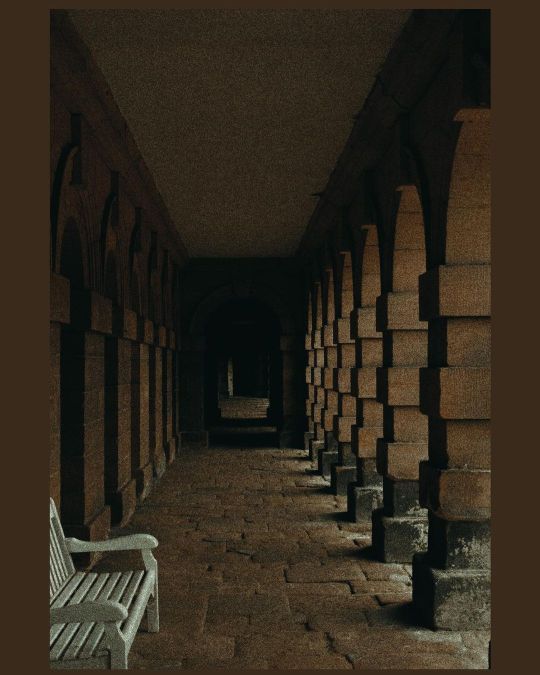
#northumberland #seatonsluice #seaside #coast #northumbriancoast #photography #sestondelval #nationaltrust #photographer #photooftheday #beach #explore #europe #nikon #d3400 #seatonsluiceharbour #seatondelavalhall (at National Trust Seaton Delaval Hall) https://www.instagram.com/p/CpK3cyQoIUi/?igshid=NGJjMDIxMWI=
#northumberland#seatonsluice#seaside#coast#northumbriancoast#photography#sestondelval#nationaltrust#photographer#photooftheday#beach#explore#europe#nikon#d3400#seatonsluiceharbour#seatondelavalhall
6 notes
·
View notes
Text
Seaton Delaval Hall.
Seaton Delaval Hall es una casa de campo en el condado de Northumberland, Inglaterra. Fue diseñada por Sir John Vanbrugh en 1718 para el almirante George Delaval.

2 notes
·
View notes
Text
0 notes
Text
I wrote recently about Newcastle's Old Assembly Rooms. William Newton, a lesser-known Newcastle architect, was born in London in 1735 and died in 1790. As architect, he built the Old Assembly Rooms. Newton's late-18th-century neoclassical civic, residential, and religious buildings were famous. Newton moved to Newcastle upon Tyne in 1776 after studying architecture with Sir William Chambers. His Old Assembly Rooms on Fenkle Street in Newcastle were famous. The Old Assembly Rooms, built between 1776 and 1778 for the town's elite, hosted dances, concerts, and plays. The building's neoclassical facade has six Ionic columns supporting a central pediment made of local sandstone. Newton designed the Old Assembly Rooms, Theatre Royal, Custom House, and Mansion House in Newcastle upon Tyne. He built Wallington Hall and Seaton Delaval Hall in Northumberland.
1 note
·
View note
Text
National Churches Trust Church of Our Lady in Seaton Delaval
Nestled in National Trust Seaton Delaval Hall.
#warrenwoodhouse#2024#places to visit#churches#church#seaton valley#seaton#seaton delaval#national churches trust#national churches trust church of our lady in seaton delaval#north east england#northumberland#tynemouth#england#uk#VisitEngland
0 notes
Text
EXAMEN 3
BLENHEIM PALACE

Nicholas Hawksmoor
Fue un arquitecto Británico nacido en 1661, Reino Unido junto a John Vanbrugh y Christopher Wren formó parte del trío de famosos arquitectos del barroco inglés. Desde 1684 hasta 1700 trabajó junto a su maestro Cristofer Wren. En proyectos como el hospital de Chelsea, la catedral de San Pablo, Hampton Court o el Hospital de Greenwich. Gracias a las influencias de Wren como supervisor general, el modesto Hawksmoor fue nombrado oficial de trabajo en el palacio de Kensington y supervisor en jefe de trabajos de Greenwich. En 1718, al ser relevado por su nuevo supervisión William Benson, Hawksmoor fue privado de su doble puesto que pasó a manos del hermano de Benson.
Algunas de sus obras más importantes fueron
St. George's Cruch, bloomsbury: iglesia anglicana en Londres, Inglaterra.
Chiste Chuch Spitalfields: iglesia anglicana en Londres.
Avadia de westminster: arquitectura gótica, catedral junto a otros arquitectos.
Iglesia de San alfegio: anglicana en Greenwich, el templo remota su primera construcción a la época medieval.

John Vanbrugh
Nació el 24 de enero de 1664 en Westminster, muere el 26 de marzo de 1726, fue un arquitecto y dramaturgo inglés mayormente conocido por haber sido el diseñador del palacio de BLENHEIM.
Vanbrugh fue en muchos aspectos un radical a lo largo de su vida de joven formó parte de la trama para derrocar al rey Jacubo II de Inglaterra y coronar a Guillermo III, protegiendo así la democracia parlamentaria.
Algunas de sus obras más importantes fueron:
Castillo de howard 1699- 1712, llamada Castillo pero en realidad no era un castillo él terminó se usaba en el Reino Unido para describir a casas con un entorno rural.
Vanbrugh Castle: Castillo medieval, con protección de grado 1.
Kung Weston House 1719 finca en Bristol Inglaterra.
Seaton Delaval Hall 1718: es una casa de campo en northumberland Inglaterra. Considerada como su mejor obra del estilo barroco inglés.
Castillo de Kimbolton, pasó a la historia por ser la morada final y prisión de Catalina de Aragón.
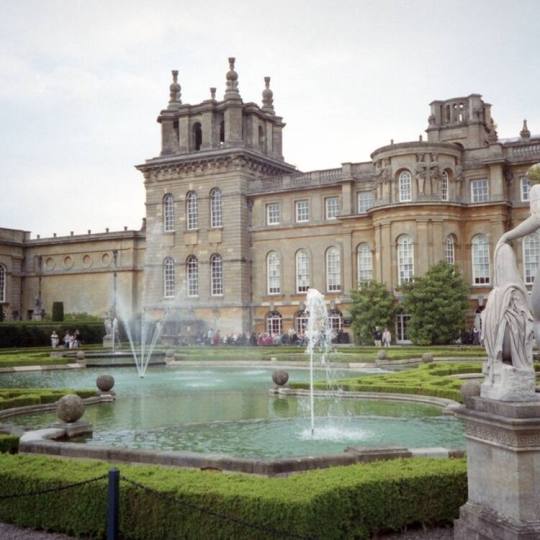
El Palacio de Blenheim, fué diseñado por el arquitecto Vanbrugh y Hawsmoore con un estiló barroco increíble, dónde la estructura sólida y elementos estructurales tales como ventanas, estatuas y jardines resaltan en todo el campo reflejando de una forma gloriosa la historia militar de la época y del triunfo del ejército, a los ciudadanos, que aunque no sea un palacio muy decorado, sus elementos conservan su estética típico del estilo barroco más sin embargo no deja de perder la esencia de individualidad en el estilo ingles al también integrar a su mismo estilo pequeños guiños que se encontrarán adecuados de distintas épocas lo cual también es un indicativo de su cultura intelectual que los hacia resaltar a la sociedad inglesa en general. El Palacio de Blenheim se retrata físicamente el ideal de que el periodo barroco en Inglaterra es una total contribución a resaltar el poderío tanto politico como económico de una sociedad porque a pesar de que normalmente se ve en la época barroca mucha aristocracia y poder religioso como cabecillas de las decisiones primordiales aquí vemos que también se podía lograr destacar el apellido a través de victorias que indicaran un futuro poderío político. Por lo tanto podemos decir que está construcción es importante ya que tiene un gran valor arquitectónico,cultural,político y militar de la época .
1 note
·
View note
Photo

South front of Seaton Delaval Hall: William Bell, 1775.
54 notes
·
View notes
Text

1826 Georgiana Carolina Dashwood (1796–1835), Lady Hastings by Henry William Pickersgill (Seaton Delaval Hall - Seaton Sluice, Northumberland, UK). Probably from artuk.org.
7 notes
·
View notes
Video
Darkest Delaval by Kris Greenwell
Via Flickr:
Seaton Delaval Mausoleum, Northumberland, UK. The mausoleum was built by Sir John Hussey Delaval as a memorial to his son John who died in 1775, aged 20, according to the Shell Guide, “as a result of being kicked in a vital organ by a laundry maid to whom he was paying addresses”. 3 image Pano. Facebook
#Urbex#arches#creepy#derelict#england#historic#kris greenwell photography#monument#nikon#northumberland#overgrown#ruins#seaton delaval#seaton delaval hall#seaton delaval mausoleum#seaton sluice#stone#uk
1 note
·
View note
